In 2000, the International Energy Agency (IEA) made a prediction: by 2020, the world would install a total of 18 gigawatts of solar photovoltaics. In 2007, just seven years later, 18 gigawatts of solar power were installed over 12 months.
Since the agency was founded in 1974, the annual World Energy Outlook was an indispensable forecasting document for policy makers around the world: yet, since 2000 everything has been wrong about the growth of renewables. Especially the form of energy that comes from the sun.
A constantly underestimated giant
The IEA, as I said, not only underestimated the adoption of solar and wind energy, but vastly overestimated the demand for coal and oil. And she wasn't the only one.
Jenny Chase, head of solar PV analysis at BloombergNEF, says: “When I got this job in 2005, I thought maybe one day solar energy would provide 1% of the world's electricity. Now it's 3%. Our official forecast is that it will be 23% by 2050, but it is completely underestimated.”
Why?
At best it is a limitation of the models adopted. Most of them were set in anticipation of slight changes to energy systems. He did not take into account a fact, evidently: every time the production capacity is doubled, the cost of solar energy from photovoltaics drops by 28%.
We have come to the point where solar is the cheapest energy source in the world in most places. This means that the models have predicted scenarios that today have totally changed.
Jenny Chase, BloombergNEF
Solar photovoltaics: the story of a triumph
This rapid and radical reduction in the price of solar photovoltaics is a worldwide job. Chinese industrial power backed by US capital, fueled by European environmental awareness and conceived largely with pioneering work by an Australian research team.
The story begins with a relay race between American presidents seeking energy independence. The first was Richard Nixon, which in November 1973 announced the Project Independence to rid the US of Middle Eastern oil. Then it came Jimmy Carter, which in April 1977 declared the energy transition “the moral equivalent of war” and invested billions of dollars in renewables research, which stopped when Ronald Reagan came to power.
Ok. All of them, however, had gained the attention of Australia.
The father of solar photovoltaics
In fact, the solar cell was invented in 1940 when Russell Shoemaker Ohl, a researcher with Bell Labs, noticed that a cracked silicon sample produced a current when exposed to light. For more than 30 years there was no great progress, then one day a called gentleman came Martin Green. It is this gentleman here in the photo.
:format(jpg):extract_cover()/https%3A%2F%2Fi.guim.co.uk%2Fimg%2Fmedia%2F7049bf8ec0a3218781d44ca453c45b56efc166ae%2F0_185_4288_2573%2Fmaster%2F4288.jpg%3Fwidth%3D445%26quality%3D45%26auto%3Dformat%26fit%3Dmax%26dpr%3D2%26s%3D7af2344d8009db84c6612f05160e0e84)
Martin Green was a young Australian engineering professor who started a research group on solar photovoltaics in 1975. A team a bit like that, working in a small laboratory set up with equipment acquired here and there from private companies.
His first experiments, done with a single doctoral student, aimed to find ways to increase the electrical voltage on the first solar cells. Gradually, they began to grind record after record. NASA had a project entrusted to six companies: Green's small group outperformed all 6 major competitors.
The next step was to build better quality cells. In 1983, these efforts yielded the world efficiency record. For 30 of the next 38 years Green would break that record.
Solar photovoltaics: the first years
In the very early years of the industry, widespread wisdom had been that a 20% conversion rate would be the limit beyond which solar PV would never go. In 1989, Green built the first complete solar panel capable of operating at 20% efficiency. It was a formidable psychological achievement. The first, true revolution in the sector.
:format(jpg):extract_cover()/https%3A%2F%2Fi.guim.co.uk%2Fimg%2Fmedia%2Fe1de1f5ea703912ce6f6e7a627c4a0f73e54b460%2F25_0_650_813%2Fmaster%2F650.png%3Fwidth%3D445%26quality%3D45%26auto%3Dformat%26fit%3Dmax%26dpr%3D2%26s%3D92d1055ea6b7737a9ce63f9ed0c0812a)
The bar was raised. Ok, 20% is fine, but solar photovoltaics (they said) will not reach more than 25%. In 2008 this limit also collapsed. And in 2015, the last milestone achieved by Green's team, nomen omen, set the conversion rate of solar photovoltaics at 40,6%.
Empire of the Sun
From this continuous chase for records the relay of the following years would be born. A relay that would have handed over the leadership of production to the Chinese solar photovoltaic industry. And this industry would be born thanks to an ambitious physicist called Zhengrong Shi.
Born in 1963 on Yangzhong Island, Shi had a master's degree and arrived in Australia a year before the Tiananmen Square protests. He had seen a flyer for a research grant, and convinced Green to take him on as a doctoral student in 1989.
Shi would finish his PhD in just two and a half years, a record still undefeated. He impressed Green and stayed with him as a researcher. When the University of Green entered into a partnership with individuals to commercialize solar photovoltaic technology, it created a public-private joint venture which it named Pacific Solar. It was 1995, and Shi was appointed deputy director in the research and development department. It lasted 5 years.
In November 2000, during a dinner, four officials from the Chinese province of Jiangsu "suggested" the researcher (now 37 and an Australian citizen) to return to the Motherland and build a factory. After some thought, Shi agreed, returned to China and founded SunTech with a $ 6 million grant from the Chinese authorities.
SunTech, the solar giant is moving
:format(jpg):extract_cover()/https%3A%2F%2Fi.guim.co.uk%2Fimg%2Fmedia%2Fb98003b4605bc6be37047bee5afefc2d3bf648c3%2F38_145_1746_1048%2Fmaster%2F1746.jpg%3Fwidth%3D445%26quality%3D45%26auto%3Dformat%26fit%3Dmax%26dpr%3D2%26s%3D9c7ff39c2ca0d79706e1ac5c4fa31a37)
Shi's arrival caused a sensation. The ability to build mass, cheap and 17% efficient solar panels was far ahead of its competitors: it was 2002. It was a shock to the Chinese. A shock they were not culturally prepared for. There wasn't a market yet, it was frustrating.
And this is where Europe comes into play. Or what everyone says is the locomotive of Europe, Germany. When Germany passed new laws encouraging the adoption of solar photovoltaics, a light bulb like this lit up on the heads of the Chinese. It was like seeing a big bat signal in the sky (dry land with bats).
It quickly became clear that global demand was going to be huge, and manufacturers around the world would be struggling hard to keep up with supply.
The consecration
:format(jpg):extract_cover()/https%3A%2F%2Fi.guim.co.uk%2Fimg%2Fmedia%2Fd6f22cca6ce524f7cd561adddec9dee34e1a72b8%2F0_60_2844_1706%2Fmaster%2F2844.jpg%3Fwidth%3D445%26quality%3D45%26auto%3Dformat%26fit%3Dmax%26dpr%3D2%26s%3D2ccd12e388f3ab5cfec2cac0b5b1b3a6)
Globalization did the rest. Spotting an investment opportunity, a consortium including Actis Capital and Goldman Sachs came knocking to convince Shi to take SunTech public. When the company went public on the New York Stock Exchange in 2005, it raised $420 million and made Shi a billionaire. So, instantly. A year later SunTech was worth about $3 billion and crowned Shi as China's richest man, nicknamed the “Sun King.”
China's photovoltaic industry won everything. SunTech alone increased its manufacturing capacity from 60 megawatts in 2005 to 1 gigawatt in 2009. The company grew so fast that its supplies of glass, polysilicon and electronic systems needed to build its panels were forced to catch up .
What could have gone wrong? Maybe you can imagine it, but I tell you anyway.
The fall of the Sun King

The rate of technological development in solar PV in China created a cutthroat industry, as with all other sectors. A sector of companies that were constantly born and died, with narrow margins and ruthless competition.
Around 2012, the global market was flooded with solar panels, causing their prices to plummet and driving SunTech's margins dangerously low. Then, the disaster. An internal investigation revealed that a takeover bid had been secured from 560 million euros in false German government bonds.
Shi was removed from the position of CEO of his company. A year later, SunTech filed for bankruptcy protection when it failed to repay a $ 541 million loan that fell due in March 2013.
The inglorious setback doesn't change history: SunTech has played a pivotal role in changing both China and the world.
Solar photovoltaic. And now?
Today Green and Shi are still in contact. They both work on new projects. Shi is overseeing a new company while Green, 72, experiments with new innovations.
One of these is one stackable solar cell. Although still a niche technology in its early stages, the basic idea is to lay a material on a solar cell to increase its power, and exploit the 40% efficiency on a commercial scale.
Today, after so many wrong predictions, the IEA finally claims that solar photovoltaics provide the cheapest energy the planet has ever known. He understood that the world we are moving in is different from how we imagined it, and everything can change quickly.


